THURSDAY
JULY 31 - 2014
Brook
Meadow
I had a walk
through Brook Meadow this morning. Pepper-saxifrage is
in bud but not quite in flower on the east side of the
Lumley area. There is an excellent crop of ripening
Strawberry Clover along the path to the east of the
Lumley area - probably the best I have seen there.
Tiny white flowers are now out on the Gipsywort on the
west bank in Palmer's Road Copse. There is plenty of
Wild Angelica in flower, attracting insects.
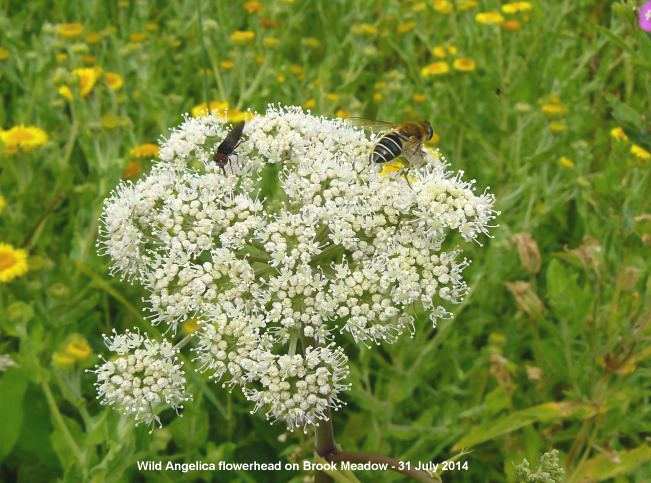
Malcolm Phillips spent
a couple of hours round the meadow today and got the
first Painted Lady of the year on the meadow.
Could this be the start of an invasion I wonder?
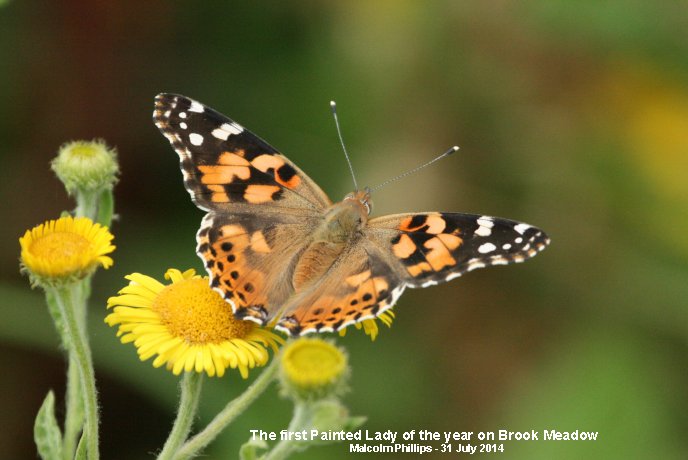
Malcolm, also saw this
rather fine spotted Trout in the stream just
north of Peter Pond. A handsome fellow!
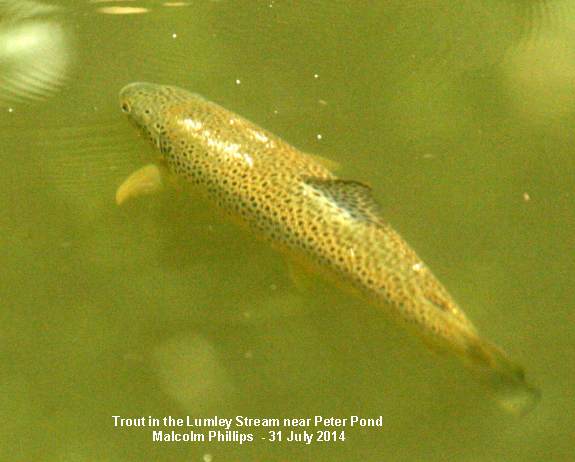
Swallows
at Lumley
I saw at least
six Swallows flying around over Lumley Road. I think
these must be from the stables at the rear of the
Lumley houses. The birds seemed to be mostly
juveniles, like the one that Malcolm Phillips
photographed yesterday.
Slipper
Millpond
I found a
total of 26 Coot on the pond and on the nearby
Dolphin Lake. A few of these are probably residents,
though my impression is that this could be the first
signs of the autumn arrival of the Coot from their
breeding grounds.
Golden Samphire is now in full flower on the
Hermitage Bridge by the main road.
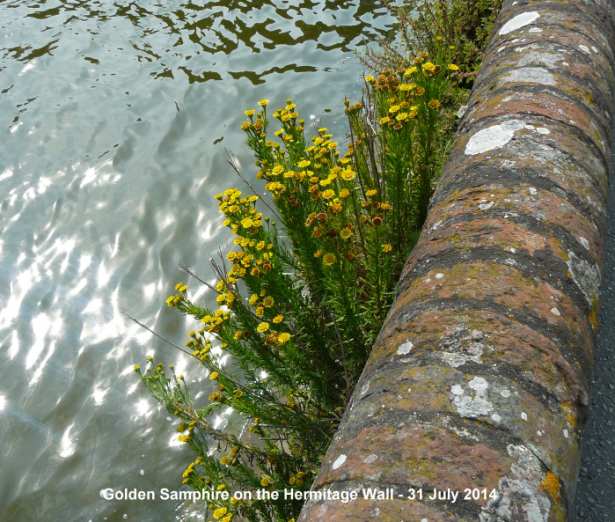
Narrow-leaved
Water-plantain
Following the
severe flooding last winter we have lost all but one
of the rare Narrow-leaved Water-plantain (Alisma
lanceolata) that used to be so abundant in the
Westbrook Stream. There are none left on the Bridge
Road Wayside site. The only remaining plant is growing
and now flowering on the edge of the canalised stream
immediately behind my back garden. This photo was
taken from my garden wall, though I previously
identified the plant from an earlier survey I did of
the whole stream. I suppose all we can hope is that
the seeds from this plant will spread downstream and
take root to produce more plants.
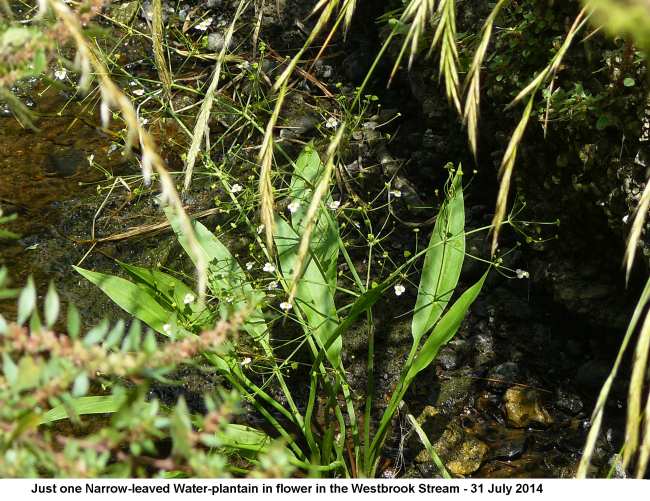
House
Martins at Westbourne
Caroline
French has previously reported House Martin nests in
Lark Avenue Westbourne, so yesterday evening David
Perks had a walk round there and found an active House
Martin's nest at no. 3 Lark Avenue in addition to the
houses listed by Caroline with small groups flying
around the estate. On his way back to Nursery Close
David called in the Hampshire Farm attenuation pond
where there were about 10 House Martins over-flying
the pond. I assume that they are birds from the Lark
Avenue colony. These are the nearest nesting House
Martins to Emsworth that I am aware of.
Hampshire
Farm
Chris Oakley
photographed a mystery damselfly in the grass north of
the Hampshire Farm pond. It is black with gold
banding. He asked the British Dragonfly Association
and they said it was a newly emerged Blue-tailed
damselfly (ischnuraelegans) that has not yet developed
its full colour.
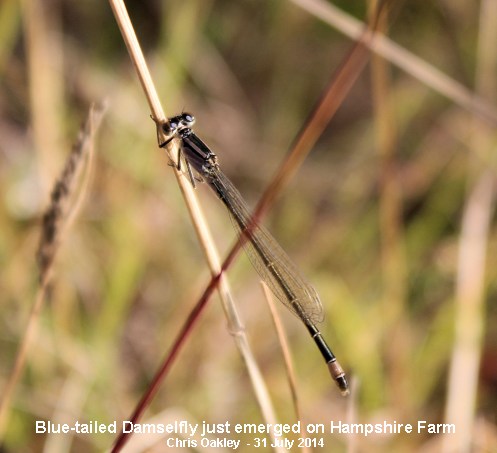
Chris says the Pied
Wagtail is back around the pond again now with six
young. Chris is still tracking down grasshoppers.
There are a lot of Common Blue butterflies over the
grass and he did spot a much bigger sky blue butterfly
the other day but couldn't get near enough to
positively identify it.
Meanwhile, in Nursery Close the foxes continue to
bring gifts. The other day it was a pair of ladies
black suede shoes with diamante decoration. This
morning there was a vacuum cleaner bag which had split
and spilled out 51p in coins. So now they are paying
for their treats.
Warblington
shore
Peter
Milinets-Raby had a wander down to the Warblington
shore today ahead of the incoming tide (10:55am to
1pm) - Conigar Point to Pook Lane. Details are as
follows:
Ibis Field: 2 Moorhen, Chiffchaff calling from hedge,
2 Stock Dove.
Hedgerow to Conigar Point: 2 juv Long-tailed Tits,
Chiffchaff calling.
Tamarisk hedge at the point: 3+ Chiffchaff
calling.
Off Pook Lane: 137+ Redshank, 8 Greenshank three with
rings N - R/RY - RG - /YYtag - and G - R/YN - 8 Grey
Plover (3 in summer), Med Gull young fledged bird, 4
Lapwing, 10 Dunlin.
Conigar Point: 5 Lapwing, 1 juv Shelduck, 22 Common
Gull, 2 Mute Swan, 4 Grey Plover (one in summer), 4
Greenshank one with rings G - R/GO - 1 winter
Black-tailed Godwit.
Colour-ringed
Spotted Redshank W+GR - Peter's most exciting
sighting from my perspective was a colour-ringed
Spotted Redshank which was in partial summer plumage -
quite black on the belly and dark mantle. It was at
Conigar Point Grid Ref: SU SU737050 This is the bird
that was caught and ringed by Pete Potts and his team
on Thorney Island on Jan 18th 2014 and as far as I am
aware this is the first recorded sighting of the bird
since it was ringed! Information sent to Pete Potts
and Anne de Potier. For full details of the ringing
session see . . . http://www.emsworthwildlife.hampshire.org.uk/x-spotted-redshank-2013-14.htm
Here is a photo of the bird I took just before it was
released.
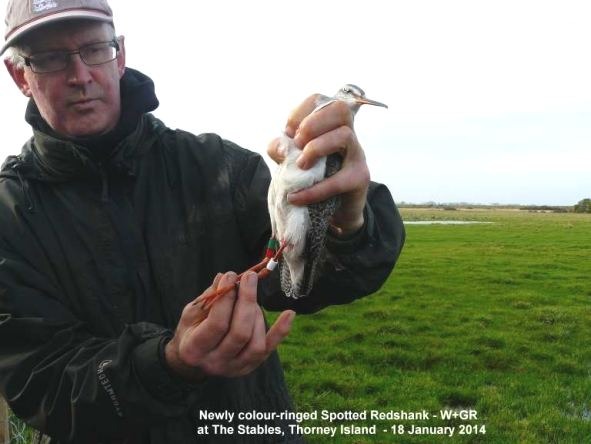
Young
Robin
Patrick Murphy
currently has a young Robin in his garden which is
quite happy to come within a couple of feet while they
are working, presumably looking for any insects which
they may disturb. Attached photo shows it is also not
camera shy - the robin was only 18 inches from the
camera!
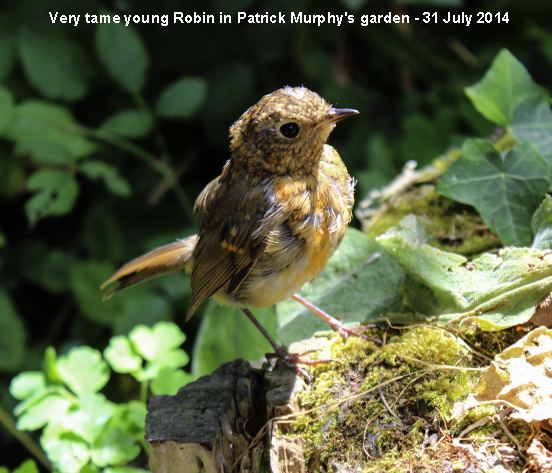
Bumblebee
takes honey water
Graham Petrie
had a stranded Red-tail Bumblebee on his patio which
appeared to enjoy some watered down honey. Graham's
photo shows the bee's tongue protruding from the
tubelike structure in its mouth to take the liquid.
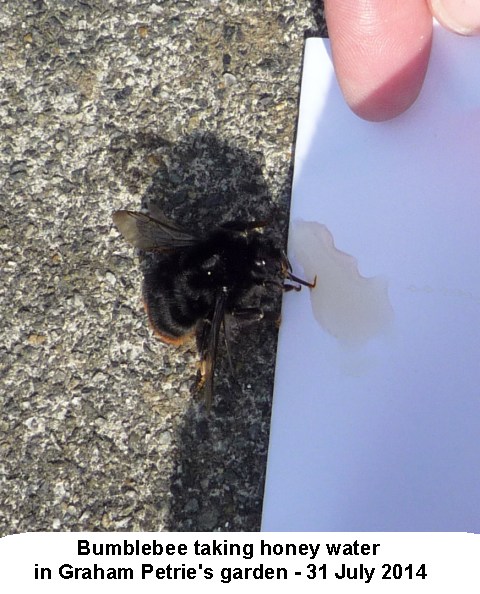
Missing
Barn Owl
Gez Watson
informed me that a male barn owl flew off yesterday
afternoon from her garden in Emsworth and hasn't
returned. He is wearing jesses and a metallic blue
ring. Please contact Gez if you see anything at
gez.watson@btinternet.com
WEDNESDAY
JULY 30 - 2014
Fort
Cumberland
I had to go
into Southsea this morning, so had a little wander
around one of my old haunts - the Fort Cumberland Open
Space. It was hot and very dry. Most prominent of the
flowers was Fennel and Wild Carrot, plus some Common
Ragwort, Viper's-bugloss, Ladies Bedstraw, Hare's-foot
Clover, Common Knapweed, Cat's-ear, Restharrow and a
small area of Sheep's-bit.
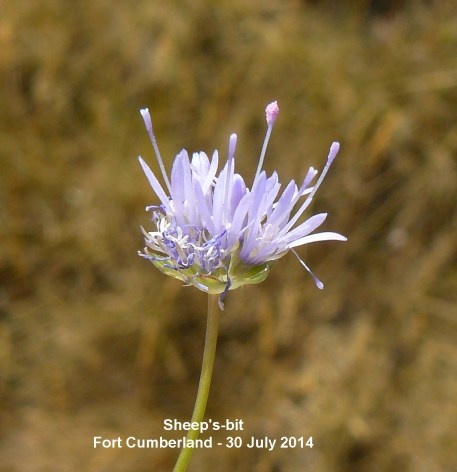
Brook
Meadow
Malcolm
Phillips went round the meadow about 3.30 this
afternoon. He saw the Kingfisher again at the top of
Peter Pond but still no photo! However, Malcolm did
get some nice shots of Swallows, including young
birds, perching on the overhead cables. Young
Swallows are duller in plumage than adults and
with forked tail that lacks streamers.
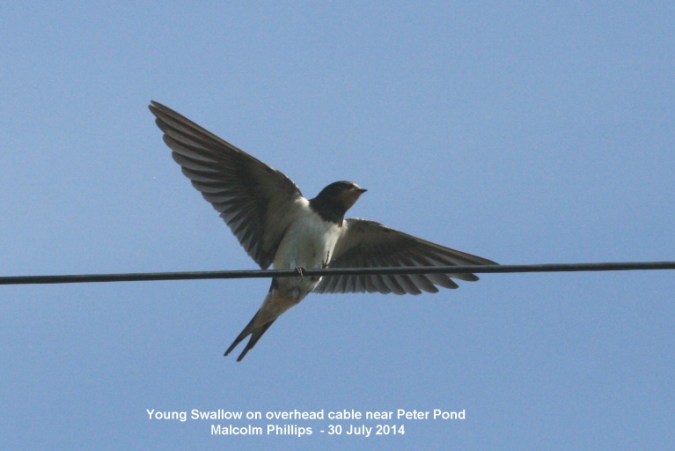
Birch
Shield Bug
Graham Petrie
found this chap on one of his Silver Birch trees in
his garden in Havant. He says it is a Birch Shield Bug
which seems logical as it was on a Birch. However, I
don't have one in my book so can't say a lot more. Any
other offers? The internet says it is not easy to
distinguish from other shield bugs!
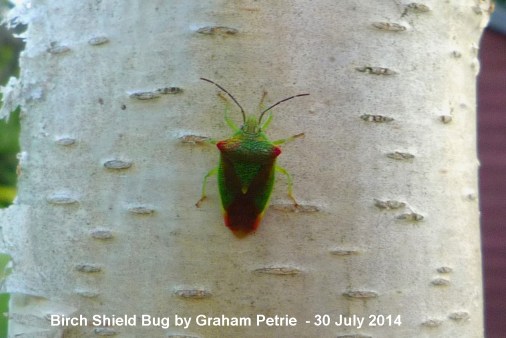
Warblington
shore
Peter
Milinets-Raby had a walk along the Warblington shore
this morning (7:02am to 8:55am - very low tide)
cutting through the Sweet Corn fields to reach Conigar
Point.
The details are as follows: There were less migrants
around than on my last visit (no Willow Warblers).
Ibis Field: In the hedge were a single Chiffchaff,
Whitethroat and a Reed Warbler (always good to see
this one away from its normal habitat), Stock
Dove.
Hedgerow behind Conigar Point: 3+ Chiffchaffs, Lesser
Whitethroat (cleaner bird than the other day - juv
type), Reed Bunting 2, Wren - Family group of 4, Stock
Doves - 2 over.
Conigar Point: 5 Common Gull, 4 Grey Plover (one in
summer plumage), 1 juv Shelduck, 13 Teal (all in
eclipse plumage - first returning birds?), 5
Greenshank - one with coloured rings G-R/BBtag, 2
Snipe flew off the tidal marsh and headed inland
(unusual record), 2 Lapwing, 1 Whimbrel, Lesser
Black-backed Gull 2 adults with 2 juvs.
Tamarisk Hedge at the point: 2+ Chiffchaff
calling.
Pook Lane: 6 Greenshank (2 with rings - both with
yellow in the combination, but too distant - probably
the same two I saw on my last visit). All eleven birds
joined to feed together at one point in the little
trickle of water in the channel. 5 Grey Plover - 2 in
summer, 5 Black-tailed Godwits - 1 in summer,
(first of the autumn?), 14 Common Gull, 14 Little
Egrets feeding together in the trickle of water with a
Grey Heron, 1 Turnstone (summer), 1 Bar-tailed Godwit
(full summer - very bright), 3 Lapwing, 21 Dunlin,
Common Tern, Mute Swan family resting on the shingle
out in the middle (2 ad and 5 young), 2 Linnets along
the sea wall.
TUESDAY
JULY 29 - 2014
BROOK
MEADOW
Annual cut of grassland
Martin Cull
came over to Emsworth this morning with his super
machine to carry out the annual hay cut of the
grassland of Brook Meadow. This is, by far, the most
important management activity of the year and the
cutting is done in accordance with the group's
management plan. Martin started with the centre meadow
and then in the afternoon carried on with the north
meadow. He will be returning to complete the job on
Thursday.
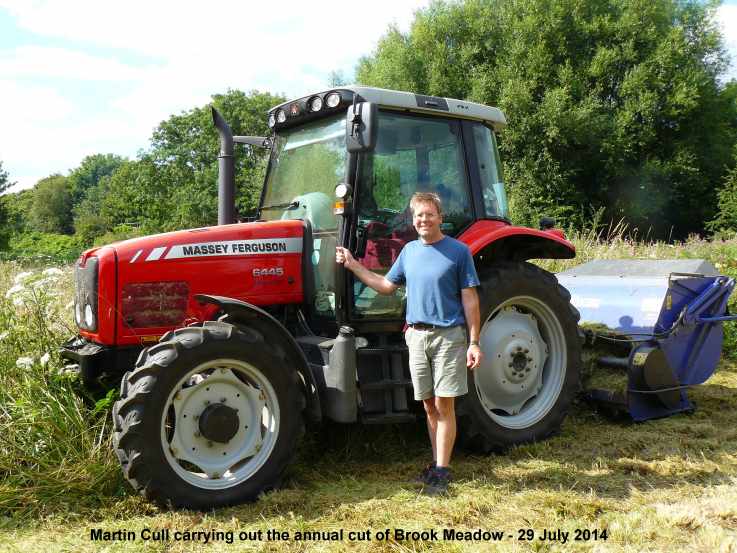
As always the annual
cutting disturbs many small animals that normally lie
hidden away in the deep vegetation. Frogs were
by far the most abundant of these today with dozens of
small creatures jumping around on north meadow
following the cut. I also noticed a couple of large
blue dragonflies flying around over the north
meadow.
For more photos see . . . http://www.brook-meadow.hampshire.org.uk/bm-diary-2014a.html
Water
Vole
Brian Lawrence
watched from the south bridge and was delighted to see
a Water Vole in greenery by the dog warning sign. This
is the second day running we have had a Water Vole
sighting after about a month with nothing. This could
have been the same animal that Malcolm Phillips saw
yesterday.
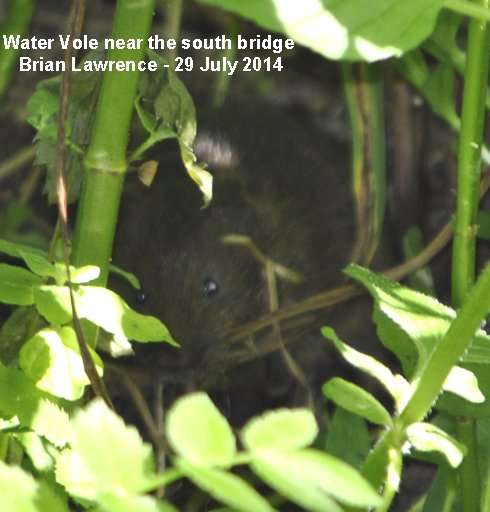
Caterpillar
Malcolm
Phillips spent most of today doing Jenny's garden in
Sultan Road. Whilst trimming some shrubs they came
across this Caterpillar, nearly 3ins long. I think it
is the caterpillar of the Eyed Hawk-moth. Like
the Peacock butterfly this hawk-moth has false eyes to
startle predators.
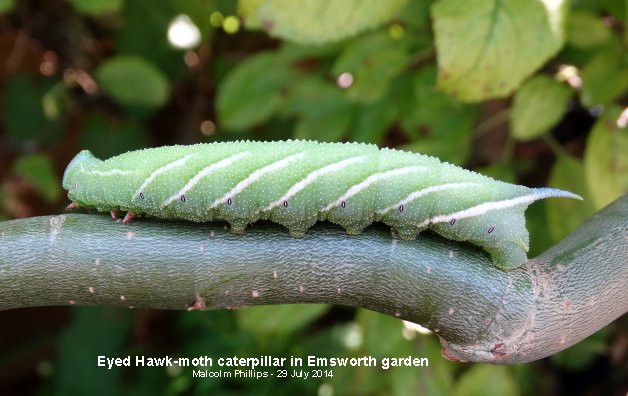
MONDAY
JULY 28 - 2014
Waysides
Surveys
I met Jane
Brook this morning for a survey of two of the waysides
in North Emsworth. we started at the Spencer's Field
verge on the east side of Horndean Road. Not much of
interest apart from a very nice patch of Upright
Hedge-parsley living up to its name by standing tall
and stiffly. This is the third and last of the common
Cow Parsley type umbellifers to flower. We also noted
some Black Bent-grass which was new to the site.
From there we had a walk along Southleigh Road (west)
without finding anything special. In fact, we appear
to have lost some of the more interesting plants that
have been there in previous years, such as Fennel,
Hemlock, Holly, Wild Carrot, Wild Radish and
Butcher's-broom.
Brook
Meadow
Malcolm
Phillips had some good sightings on Brook Meadow
today. Most important he saw a Water Vole on
the river bank beneath the south bridge. This was our
first Water Vole sighting for a whole month. It is
good to know they are still there.
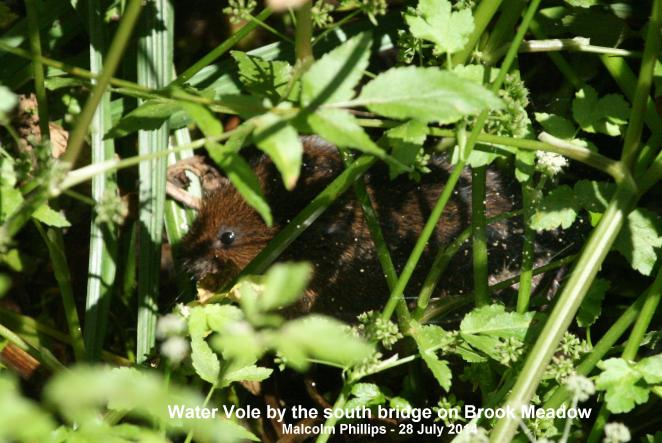
For Water Vole news
and photos see . . . http://www.brook-meadow.hampshire.org.uk/bm-water-voles-2014.html
Just as important was
the sighting of a juvenile Blackcap confirming
the successful breeding of this species on Brook
Meadow this year. Juvenile Blackcaps, like the adult
females, have brownish heads; male juveniles will
gradually acquire the black head over the first year.
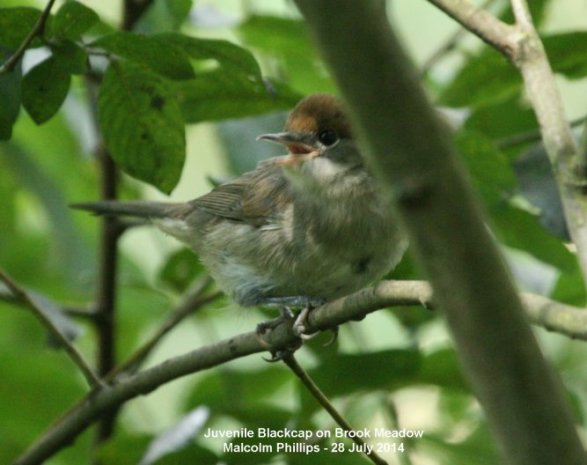
Malcolm also got a
young Wren. Good to see they have bred
successfully too.
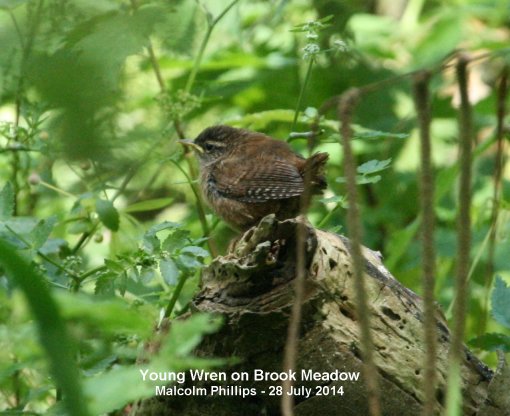
'Goldfish'
correction
Regarding the
'goldfish' that Malcolm Phillips has seen on a couple
of occasions in the stream near Lumley Mill, Mike
Wells wrote to say it was, in fact, a Golden Orfe.
Mike has about 20 in his pond, measuring up to approx.
18 inches in length - see the photo below. He has had
them for over 30 years! He thinks the fish in the
Lumley Mill stream was probably dumped by someone who
did not want it any more.
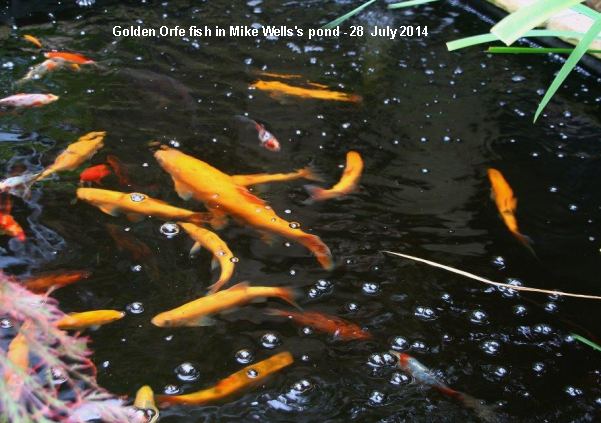
Red-headed
Grasshopper correction
Bryan Pinchen
had a look at the 'Red-headed Grasshopper' that Chris
Oakley took on the Hampshire Farm pond picture on July
26.
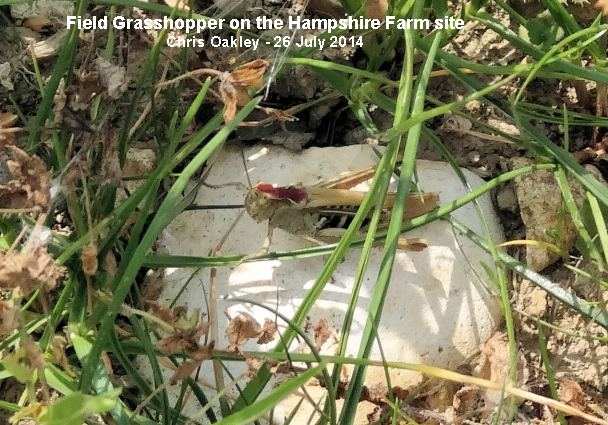
In fact, it is a
Field Grasshopper (Chorthippus
brunneus). Bryan says this species throws up many
colour forms, ranging from the 'typical' grey brown
colour through to greenish, reddish and even pink
forms and every colour and colour combination in
between. A close look at this species should also
reveal that it is covered in rather dense fine hairs,
the only British species like this. The characteristic
white 'X' mark on the top of the pronotum immediately
points to it being this species.
Bryan says our grasshopper species do show huge
variation in their colouration but all can be
identified by the shape and markings on the pronotum
which are illustrated in his identification guide.
'Pocket Guide to the Grasshoppers, crickets and allied
insects of Britain and Ireland' by Bryan Pinchen.
Forficula Books, 2006.
Interestingly, Chris
sent me another photo of what is probably another
Field Grasshopper, but this one has a completely
different colouring. Significantly, the white 'X' mark
mentioned by Bryan shows up well on the pronotum.
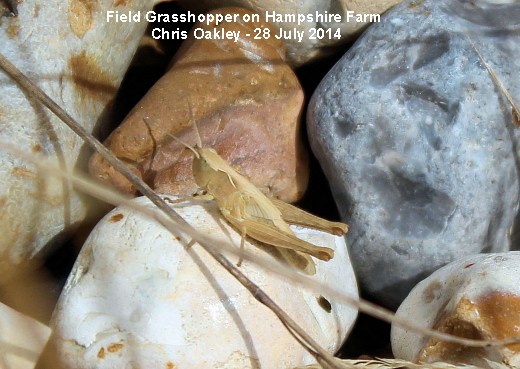
Bee
Eaters on Isle of Wight
Ralph Hollins
alerted me to the fact that a pair of Bee-eaters have
nested on National Trust land on the Isle of Wight and
the chicks have hatched. An observation area has been
set up for visitors to enable them to see these
beautiful birds, but well away from the actual nest
site to avoid disturbance. The site is at Wydcombe,
grid ref SZ 511 778, postcode PO38 2NY. See link for a
photo and more news. https://www.facebook.com/IsleofWightNT?fref=ts
SATURDAY
JULY 25 - 2014
Brook
Meadow
Malcolm
Phillips was on the meadow early this morning in the
hope of getting a photo of the Kingfisher which he saw
yesterday at the top of Peter Pond and again today,
but still no photo. Whilst standing waiting to see if
he came back he saw a small bird in the reeds,
probably a Reed Warbler. He also went up to Lumley
Mill to see if the large 'Goldfish' was still there
that he saw yesterday. Sure enough it was swimming
around the same area by the mill. Where the heck has
that come from?
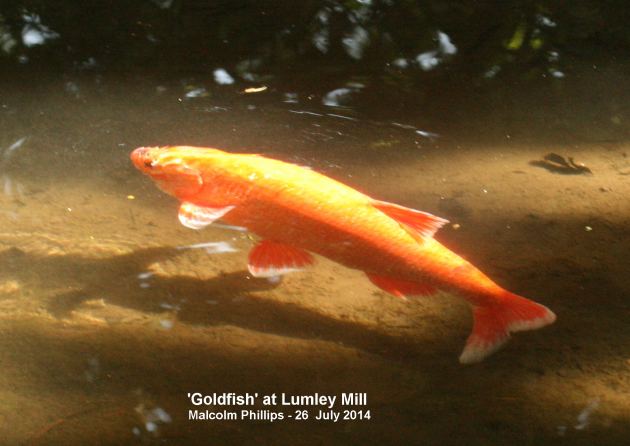
Hampshire
Farm
Chris Oakley
poses two puzzles. Firstly the Roe Deer that regularly
visits the pond on the Hampshire Farm site appears to
have only one horn. Presumably the second horn is
still to grow?
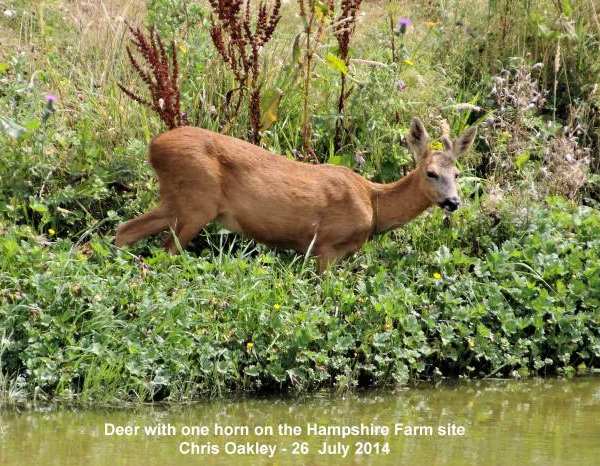
Secondly Chris got a
shot of an unusual grasshopper with a reddish
pronotum. I can't find it in Chinery, but Chris has
located a Red-headed Grasshopper on the
internet which is an American species from New
Hampshire! The image on Google does look remarkably
like Chris's photo!
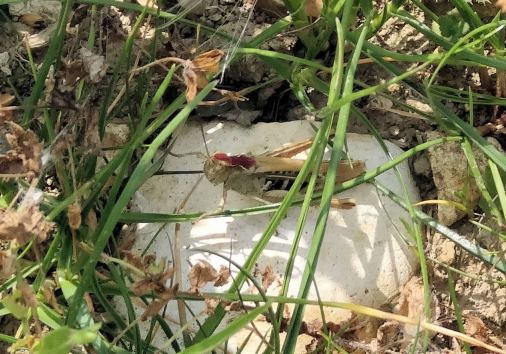
Warblington
- Emsworth
Peter
Milinets-Raby was out this morning for a walk along
the Warblington shore via the fields behind Conigar
Point (7:10am to 9am. Ibis field: 2+ Chiffchaff in
hedge along with male female Blackcap, Whitethroat, 9
Chaffinch and 8+ Swallows over.
Field hedgerow behind Conigar Point (fields now full
of sweet corn): 20+ Chiff/Willow Warblers (at least 6+
Willow Warbler identified and 15+ Chiffchaffs seen,
With them were Lesser Whitethroat, 15+ Long-tailed
Tit, Blue and Great Tits, 2 Stock Doves
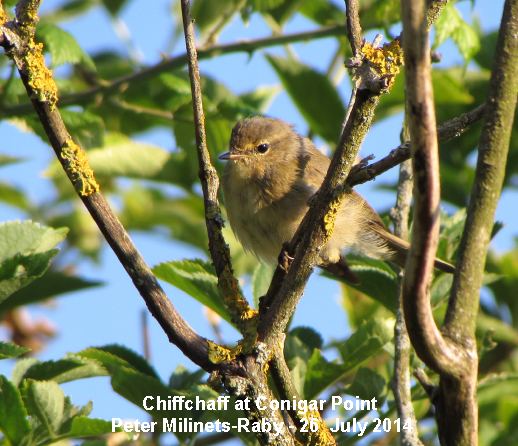
Conigar Point: 2
Whimbrel, 21 Common Gull resting with 200+
Black-headed Gulls, 6 Lapwing, 4 Curlew, 2 Little
Egrets, Common Tern, In Tamarisk hedge 2 Willow
Warbler (one occasionally singing), 2+ Chiffchaff,
Reed Warbler seen in Tamarisk hedge and one heard
singing from reed bed.
Off Pook Lane: 5 Greenshank (two with rings -
RG-/YYtag- and NR-/YY-), 2 Grey Plover in summer
plumage, 2 Common Tern, Little Tern, Mute Swan family
in the middle of the channel heading east (2 adults
and 5 juvs). Not seen them on the pond for a few
days.
This evening the family went for a walk around
Emsworth Harbour. The highlights were 2 Lesser
Black-backed Gulls and 2 Med
Gulls.
Iping
Common
Heather Mills
reports on this morning's walk by the Havant Wildlife
Group. See the report at . . . http://familyfellows.com/hwg-walk-reports-2014.htm
FRIDAY
JULY 24 - 2014
Brook
Meadow
I had a gentle
walk through Brook Meadow this morning on the way to
the shops. I walked down the main river path where I
spotted what I think might be a female Beautiful
Demoiselle. Female Banded and Beautiful
Demoiselles are difficult to distinguish, but my book
says the female Beautiful Demoiselle has broader wings
with a brownish tint which seems to fit this insect.
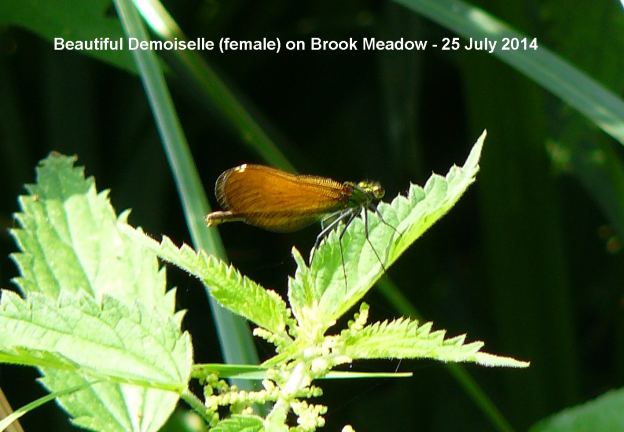
I also found Water
Mint in full flower around the Lumley area. What a
cracking flower that is.
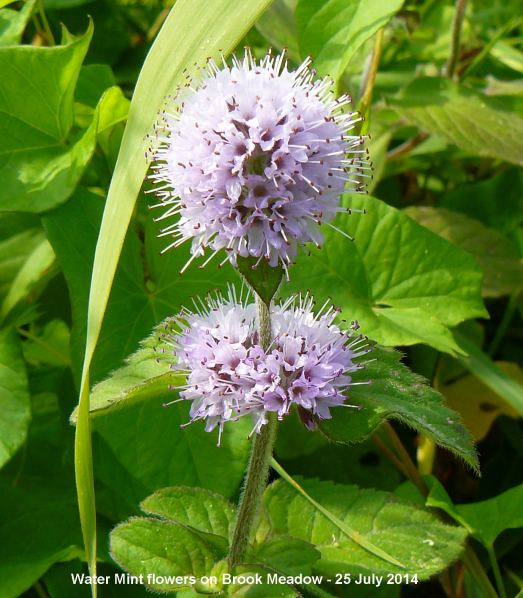
Malcolm Phillips got the first Cinnabar caterpillar
of the year on the meadow. But I wonder what it is
feeding on? That does not look much like Common
Ragwort which, in fact, is very scarce on the meadow.
Maybe, it has found the Hoary Ragwort?
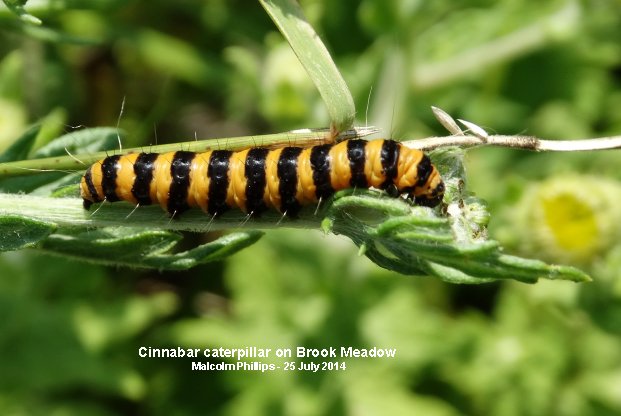
Millpond
News
Jackie-Michelle
Daines was down at the town millpond at 8am today with
her camera. All is well with the Mute Swan family and
the cygnet is looking and feeding well.
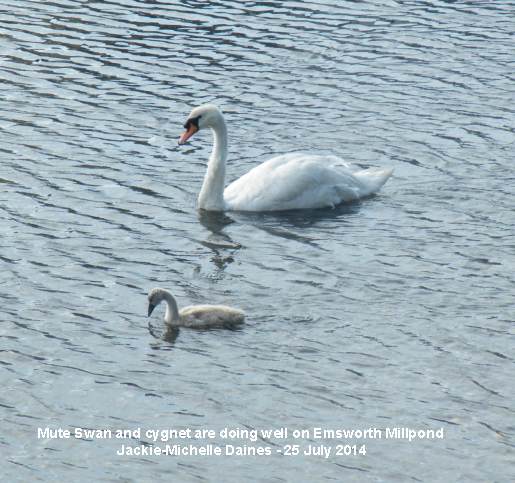
Cuckoos
in Africa
British Trust
for Ornithology reports that the Cuckoo migration is
well under-way, with seven Cuckoos in Africa, five of
which were tagged this year. The rest are scattered
across Europe with the last one, 'Derek', having left
this week. The map is changing every day so keep an
eye on it here . . . http://bto-enews.org/NXK-2MSVS-3UEDCR-16PKG5-0/c.aspx
Interestingly, the
Cuckoo named 'Emsworthy' has made it to Africa, having
flown across the Mediterranean at almost the widest
point and making the crossing around 515 miles from
his last location in southern France. He is now in
northern Tunisia. 'Emsworthy' has nothing to do with
our home town, but was named after Emsworthy Mire in
Devon, where the bird was tagged.
Swifts
on their way
We are still
seeing a few Swifts flying around the houses in
Emsworth, but soon they will be gone. They are one of
the first migrants to arrive and the first to leave.
They have a 14,000 mile migration back to Africa.
Swifts in the south of the country leave earlier than
the birds in the north but by the end of August they
will all be more or less be gone. Young Swifts are
fully independent on leaving the nest, and will depart
for their wintering grounds a few days after fledging.
See . . . http://bto-enews.org/NXK-2MSVS-3UEDCR-16PKG7-0/c.aspx
Is
it too late for pessimism?
Ralph Hollins
recommends viewing a 90 minute BBC 4 film showing the
beauty and fragility of our planet with superb aerial
photography, and delivering alarming statistics about
climate change that could make Earth uninhabitable. We
have only got 10 years! Scary stuff, but a beautiful
film. Here is a link to the programme (for the next 6
days only). . . http://www.bbc.co.uk/iplayer/episode/b04bdtqt/our-planet-from-the-air-home
Ralph thinks this film
should be compulsory watching for all the world's
youth as they come to the end of their formal
education, and for every politician before they are
allowed to put themselves up for election. See Ralph's
comments in full on his diary at . . .
http://ralph-hollins.net/Diary.htm
WEDNESDAY
JULY 23 - 2014
Brook
Meadow
I had a slow
walk through the meadow on a very hot morning.
Peacock butterflies were abundant on the orchid
area; I counted at least 10, all feeding on Common
Fleabane with wings closed, showing only the black
underwings.
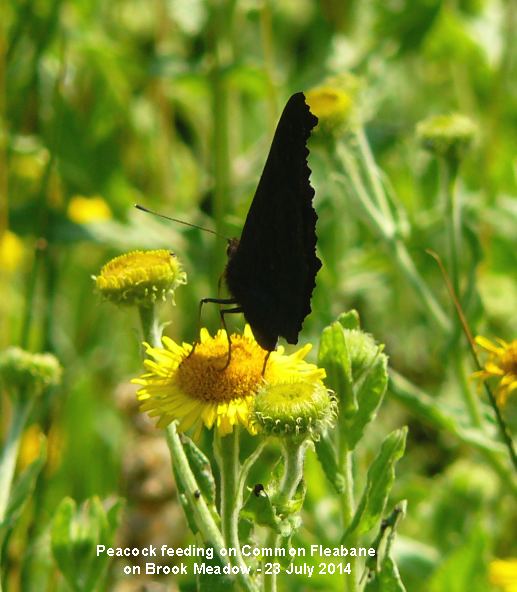
The Great Burnet is
still standing tall with bright red flowerheads. There
is plenty of Strawberry Clover along the edge
of the path around the Lumley area, much of it now
turning into the strawberry-like fruits, good enough
to eat!
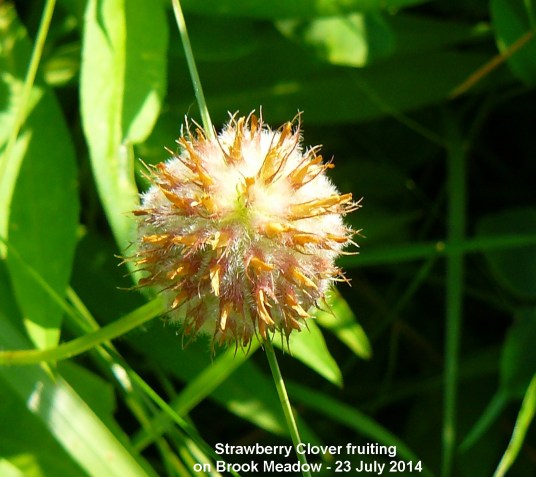
The yellow-flowered
Japanese Honeysuckle is flowering by the
Lumley gate. They key differences from the native
Honeysuckle are: flowers are in pairs, leaves are oval
and pointed and berries are black not red.
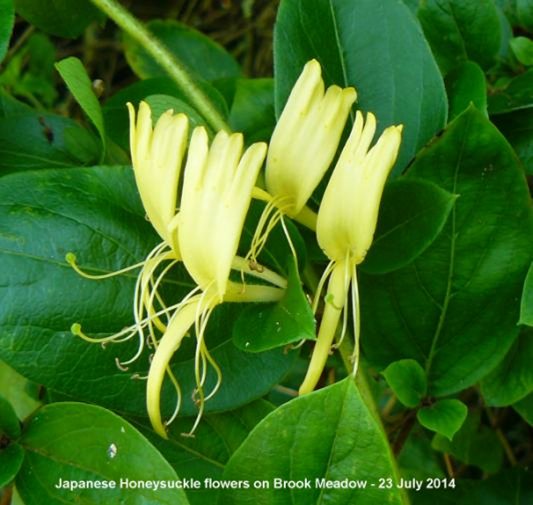
Hampshire
Farm
Chris Oakley
was on the Hampshire Farm site again - "very hot and
very humid". He had this Pied Wagtail on the pond
fence with a collection of insects. It flew off into
the Wren Centre. It was probably collecting insects
for youngsters in the nest.
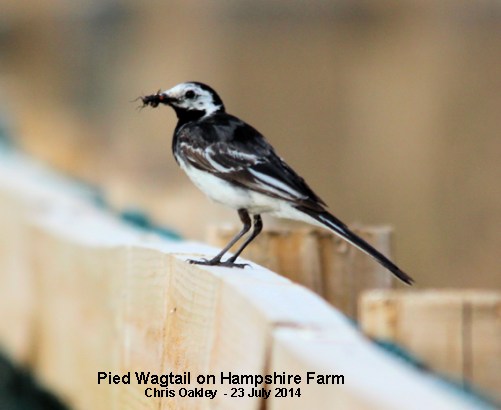
Chris has been
collecting plant seeds and found some Wild
Oats, which as he says are "really are the most
peculiar things, looking like more like insects than
seeds". He believes they are used by fly fisherman as
lures for Trout. In fact, what Chris has photographed
are the detached florets from the plants with the long
bent awns still attached. These apparently, assist the
plant in seed dispersal by animals.
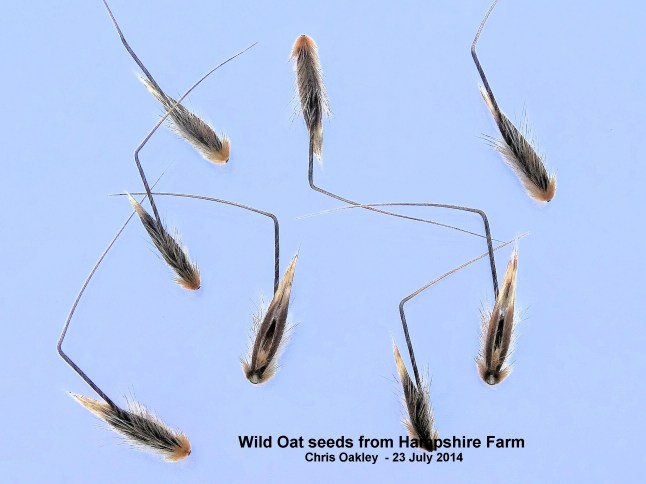
Wild-oat (Avena
fatua) was introduced in this country many
years ago with cereal seeds and has hugely increased
in frequency over the last 60 years. Despite its large
and attractive spikelets and graceful panicle,
Wild-oat's reputation as a troublesome weed has
entered the language as a metaphor for careless
procreation, particularly amongst youth, 'sowing
wild-oats'!
Millpond
News
Jackie-Michelle
Daines provided the latest up date on events on the
town millpond relating to the swans. Yesterday a work
team from Havant Borough Council arrived at the
millpond to remove the swans' nest which they said was
smelling. They were challenged by two residents who
told the workmen not to remove the nest as the swans
were still using it and there was still a cygnet using
the nest. The nest is still being used by the pen and
cygnet every night. The work men rang their boss for
instructions and smartly returned to apologise to
residents for the misunderstanding. The nest will not
be touched until the pen and cygnet have stopped using
it. Jackie has checked the law which says it is a
criminal offence to move or remove a swan's nest that
is still in use. Once the nest has been abandoned it
can be removed but only then by a certified person.
Jackie says the pen is now moulting and looks very
dishevelled, but she and the cygnet are still very
active the cygnet is still looking well.
Monarch
butterfly ?
Whilst in a
garden in Beacon Square this afternoon Lin Senior saw
a very large butterfly, heavier in flight with
striking markings, which made her immediately think of
Monarch. She wonders if there has been any other
sightings. I certainly have not had one myself, nor
have I have any reported. But it is worth keeping a
look out. It is a very large butterfly, twice the size
of a Peacock with orange and black wings. It tends to
flap and glide. It is an North American butterfly, but
does occasionally go off course and lands up in the
south of England. There has been none reported on
either the Hants or the Sussex Butterfly Conservation
sites.
TUESDAY
JULY 22 - 2014
Millpond
News
Jackie-Michelle
Daines says that all is unchanged on the town millpond
as of 10pm last night. The Mute Swan family with one
cygnet is still intact; they are still using the
'litter nest' by the bridge at night. Jackie thinks a
small footed person has removed the last swan egg from
the nest going by the foot prints in the mud all
around the nest. The swan nest is also being used by
two Mallard families during the day; both families are
doing well with no further losses.
Environment Agency staff were on site yesterday trying
to put some of the water back in to millpond that they
took out on Friday. They informed Jackie and other
residents present that as they were trying to reopen
the gates they recovered two cygnet bodies from the
sluice chambers. This confirmed Jackie's suspicions as
to where two of the cygnets were lost. Clearly, foxes
were not responsible, as I first thought. Jackie
thinks the third cygnet was taken by a predator in the
Westbrook Stream north of the grill. The Environment
Agency staff will be returning today at both high
tides to try and add more water to the millpond to at
least cover the stinking mud.
Warblington
Peter
Milinets-Raby was out again around the Warblington
shore this afternoon (12:55pm to 2:10pm - very low
tide and dreadful heat haze. Main sightings were:
Off Pook Lane: 5 Greenshank (one with geo tag - too
distant to read), 11 summer plumaged Dunlin, 82
Redshank, 4 Curlew.
Off Conigar Point: 16 Lapwing, 3 Curlew, 2 Greenshank,
4 summer Dunlin, 2 Lesser Black-backed Gulls plus two
juvs, 2 Great Black-backed Gulls, Common Gull. Reed
Warbler singing from small reed bed. Chiffchaff
calling from Tamarisk hedge. 20+ Swallows over the
point, 2 Sand Martins amongst them. Turtle Dove in
field by point, then flew into hedgerow (nice
surprise).
Warblington cemetery: Young Chaffinch being fed by
adult male.
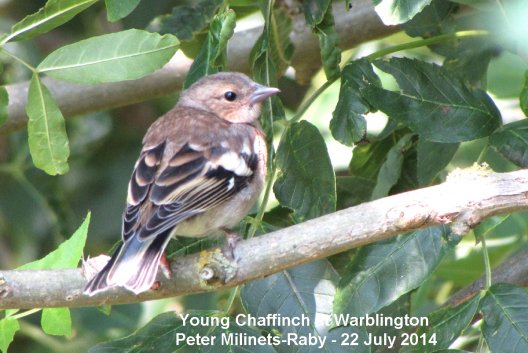
Peter also had this
giant Hoverfly in his garden this evening - huge. At
first he thought it was a Hornet. Later he looked it
up as Volucella zonaria.
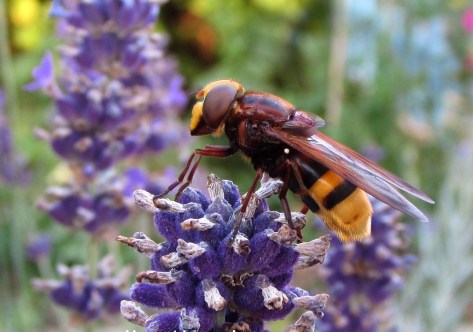
MONDAY
JULY 21 - 2014
Railway
Wayside
Jane Brook and
I did a survey of the wayside north of the Emsworth
Railway Station on this very hot and sunny morning.
The whole wayside has a masses of wild flowers,
creating a fine multi-coloured spectacle. The most
prominent flowers were Wild Carrot, Common Knapweed,
Marsh Woundwort, Common Fleabane, Common Ragwort,
Spear Thistle.
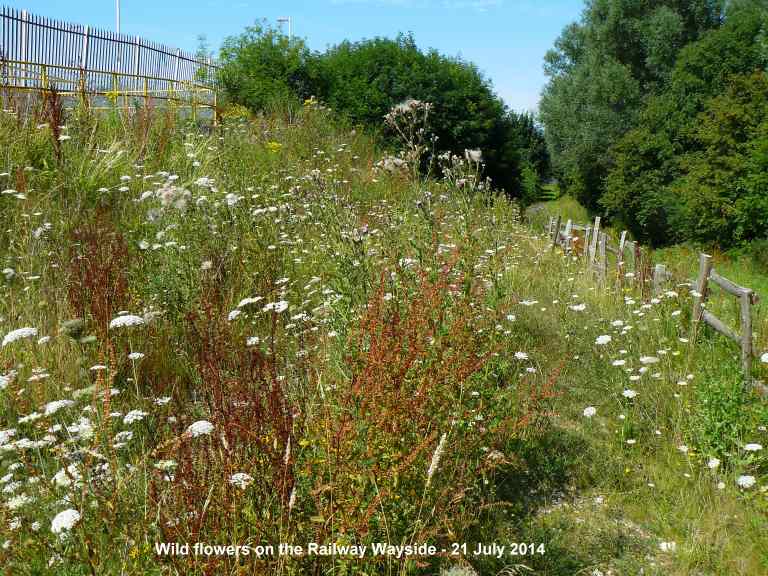
Plants newly flowering
included Agrimony, Canadian Goldenrod, Hairy
Buttercup, Hard Rush, Hoary Ragwort, Italian Ryegrass,
Marsh Cudweed, Meadow Vetchling, Rosebay Willowherb
(in the small sector near the hoardings), Scented
Mayweed, Selfheal, Redshank, Hemp Agrimony, Upright
Hedge-parsley.
In addition we found some Timothy grass with very long
panicles - up to 16cm - on the highways track to the
north of the wayside. Cope and Gray give the upper
limit at 20cm, but these were the largest Timothy
panicles I have ever seen.
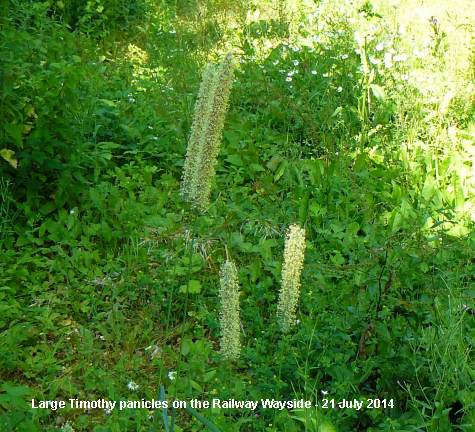
We also found several
tufts of Toad Rush at the eastern end of the
highways track. This is a distinctive rush with a
slender stem either single or repeatedly branched at
the base and forked above with a floret in each fork
and other florets along and at the tips of the
branches. The plants were up to 25cm tall which Rose
says is an exceptional height.
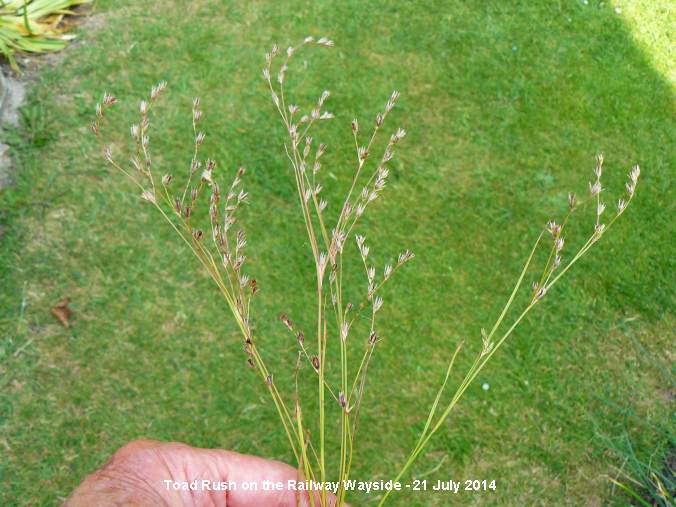
We found some
bent-grasses with large panicles which I think could
be Black Bent-grass. The total number of plants
recorded on this wayside in 2014 is 109. Many of the
less common plants which were seen when the wayside
was first established appear to have gone. But that is
still a good number, exceeded only by the Bridge Road
Wayside which has 128.
Insects
A good number
of butterflies were on the wing, mostly Common
Blues. Here is a female Common Blue.
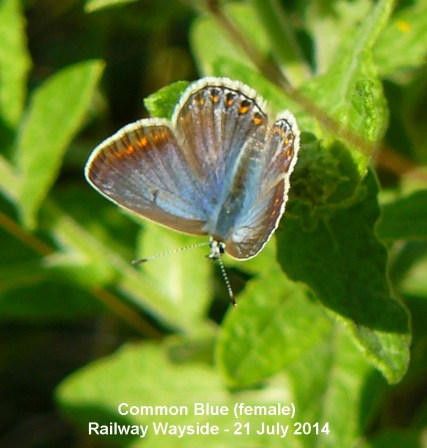
But the best butterfly
of the morning was a Clouded Yellow which was
feeding for a while on the flowers of Common Fleabane.
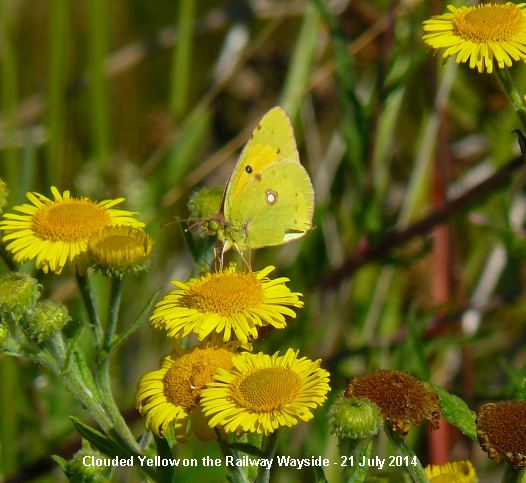
Other
news
On the way to
the station I noticed that Black Spleenwort is still
growing on the front garden wall of house number 90A
North street, just to the south of the entrance to
Emsworth Railway Station.
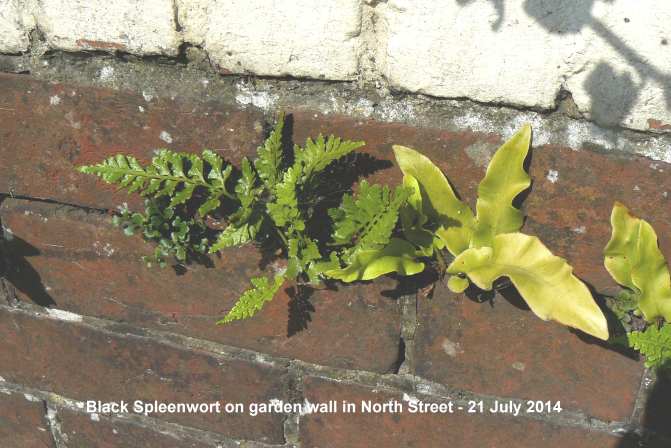
Essex
Skipper
Malcolm
Phillips was on the meadow today and got lots of
butterflies as usual including one new one for Brook
Meadow for 2014 - an Essex Skipper. Essex Skipper is
very similar to the Small Skipper except for the
distinctive black tips to its antennae which show well
in Malcolm's photo.
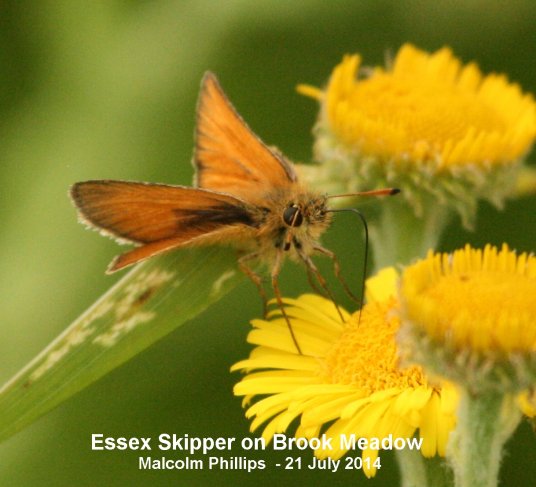
Terrapins
Mike Wells was
at Petersfield Lake today where he found several
Terrapins sunning themselves. They used to be common
on Baffins Pond, though I have not had any recent
reports from there. As Mike says, with their
omnivorous diet quite a few ducklings will have
disappeared.
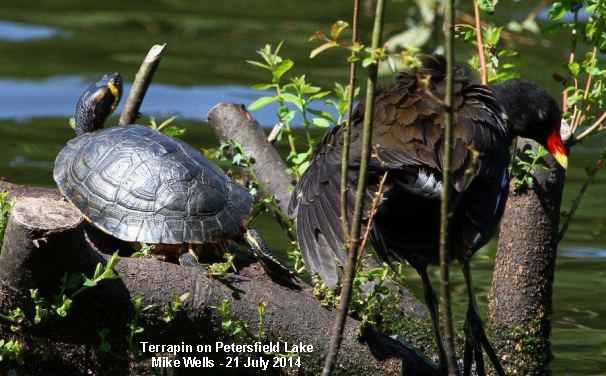
SUNDAY
JULY 20 - 2014
Emsworth
This morning,
Jean and I walked down to the Deck Cafe in the marina
for coffee. On the way through Brook Meadow we saw the
first Bulrush flower spikes of the year on the
west bank north of the observation fence. That's good
as we did not have any at all last year.
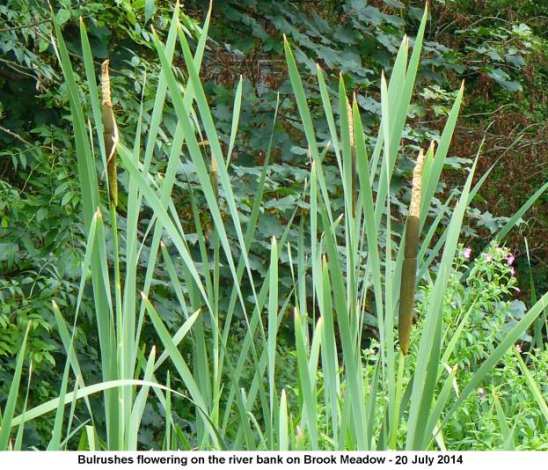
The Horse
Chestnut tree by the Lumley gate is loaded with
conkers. It should be a good year, though the kids
don't play them any more.
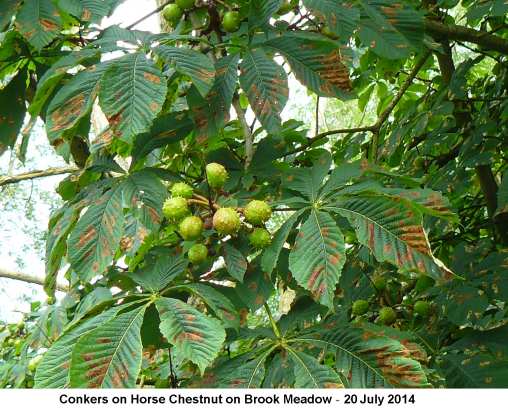
There was no sign of
any Great Black-backed Gulls (adults or chicks) on
Slipper Millpond meaning they have probably moved on.
Teasels are out on the east side of the pond.
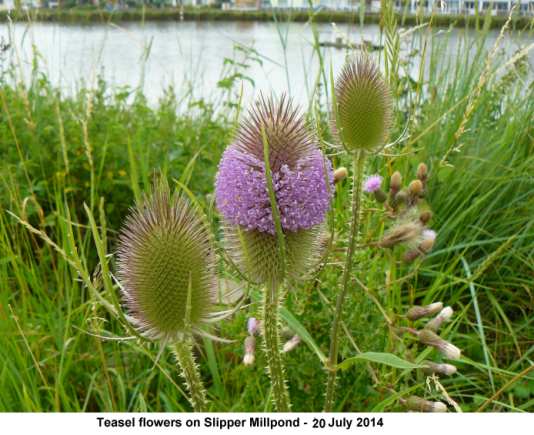
The tiny yellow
flowers of Prickly Lettuce are out on the west
side.
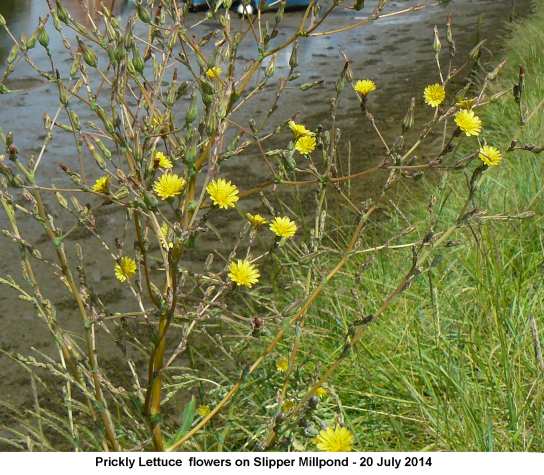
Langstone
Mill Pond
Peter
Milinets-Raby visited Langstone Mill Pond ahead of the
incoming tide this afternoon (4:45pm to 6pm) Off
shore: 86 Redshank, Whimbrel, 5 Lapwing, 4 Med
Gulls.
Mill Pond: 6 Grey Herons - 3 of them juvs, Loads of
Little Egrets (counted 46 before I gave up) some still
in the nest by probably only days from fledgling. 30+
Swallows overhead. A family group of Reed Warblers
close to the edge of the pond (2 ads with 3
young).
And surprise, surprise a female Tufted Duck with a
family of 7 ducklings (brutally chased away into a
dark corner of the pond by the Mute Swan family (with
5 cygnets).
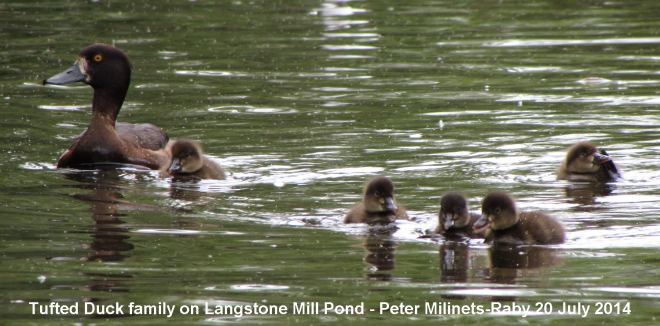
FRIDAY
JULY 18 - 2014
Brook
Meadow
I found
Giant Fescue for the first time this year on
the Brook Meadow site along the path through Palmer's
Road Copse. This is the only area where this grass
grows on the meadow site, but there is considerably
less than there has been in previous years. This takes
the totaal number of grass species recorded on Brook
Meadow this year to 29.
The tiny white flowers of Gipsywort were also
out on the river bank in Palmer's Road Copse for the
first time this year. Gipsywort was always a scarce
plant on Brook Meadow until this year when it suddenly
became abundant on the river bank following the winter
flooding.
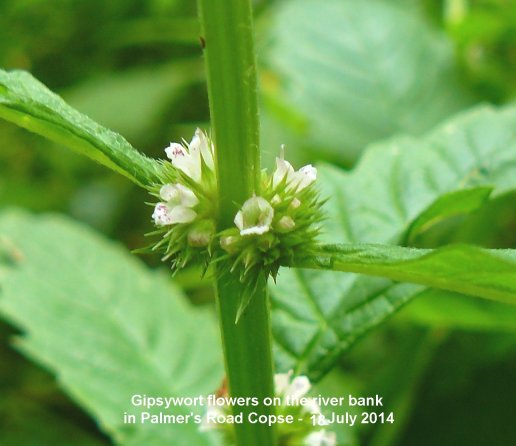
Slipper
Millpond
The Mute
Swan family with their two cygnets that nested in
the reedbeds on Slipper Millpond were on the pond. The
two cygnets are now growing well.
The Great Black-backed Gull chick has moved
from the centre raft to the south raft where I found
it this morning. It looks a good strong healthy bird
and probably flew the short distance between the
rafts, but it will be a little while before it finally
moves away from the security of the pond. One of the
adults flew in while I was there, but ignored the
chick and settled on the centre raft.
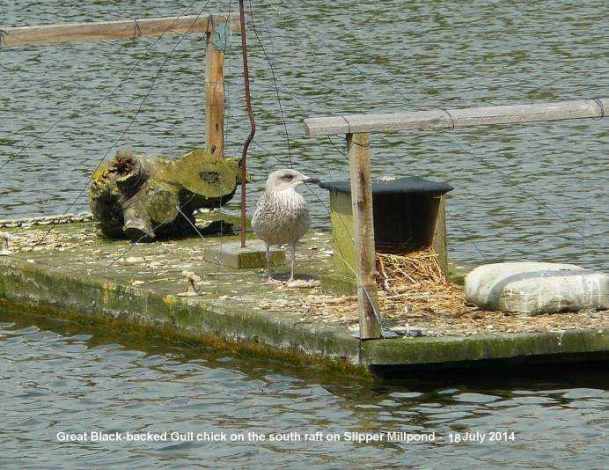
Stone Parsley with
tiny white flowers is out on the east side of Slipper
Millpond.
Other
millpond news
There are two
family of ducklings on Peter Pond, one of eight and
the other of three. The mother of the smaller family
is a white Mallard though her offspring are all
regular brown.
The Mute Swan family are still intact with their one
small cygnet on thetown millpond.
Brook
Meadow
Malcolm
Phillips had a good time around the meadow taking
photos of lots of butterflies including this rather
nice Common Blue.
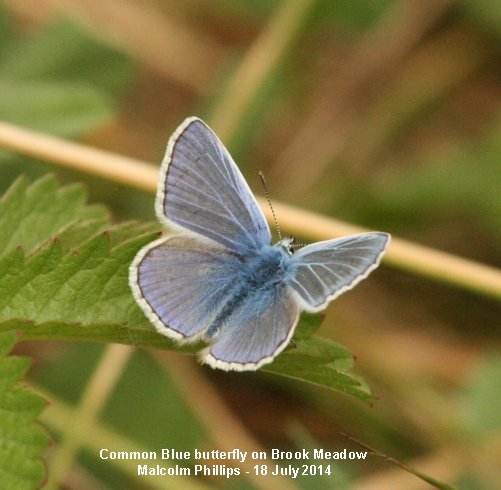
Malcolm also got a
good image of the female Common Darter.
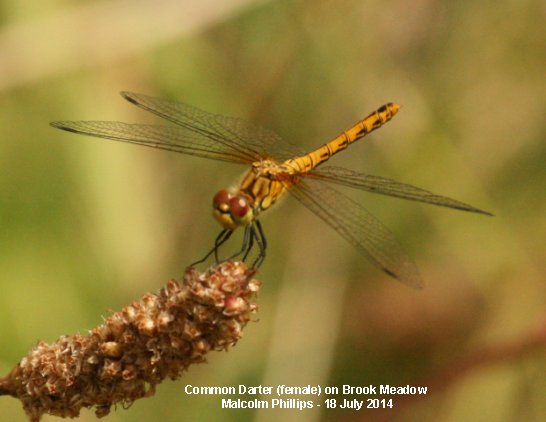
Foxes
and eggs
I have had two
replies regarding the egg-delivering foxes reported by
Elaine Morgan (blog for July 16). Chris Oakley said
his mother-in-law who lived in Gosport had exactly the
same thing happen to her. Her friend, who looked after
her garden, used to find hen's eggs buried in the
flower border. Nobody knew how they got there but it
was assumed foxes were to blame.
Chris Gibbs contacted me to say when he used to live
in Roundhouse Meadow, several of his neighbours found
Swan's eggs in their flower pots. They assumed they
had been cached by foxes.
Crab
spiders and butterflies
Crab Spiders
are clever creatures. They lie on flowers waiting for
their prey to turn up, adopting the colour of the
flower so as to make themselves less visible. Chris
Gibbs relates a story about a white Crab Spider that
he had on the white cosmos flowers in his garden; it
caught a Small White butterfly which was at least
three times its size, but its venom soon immobilized
the butterfly. Tony Wootton also sent me a photo of a
Crab Spider attacking a Skipper butterfly which he
took while on holiday in The Alsace. Again, there's
probably no hope for the butterfly.
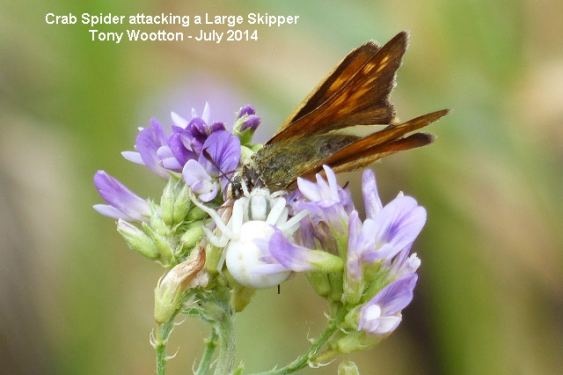
THURSDAY
JULY 17 - 2014
Brook
Meadow
I went over
for the regular work session where there was an
exceptional turn out of 18 volunteers. The main job
was laying the path to the new shed in the Seagull
Lane patch. Here is Maurice Lillie preparing the
gravel for the path to the tool shed.
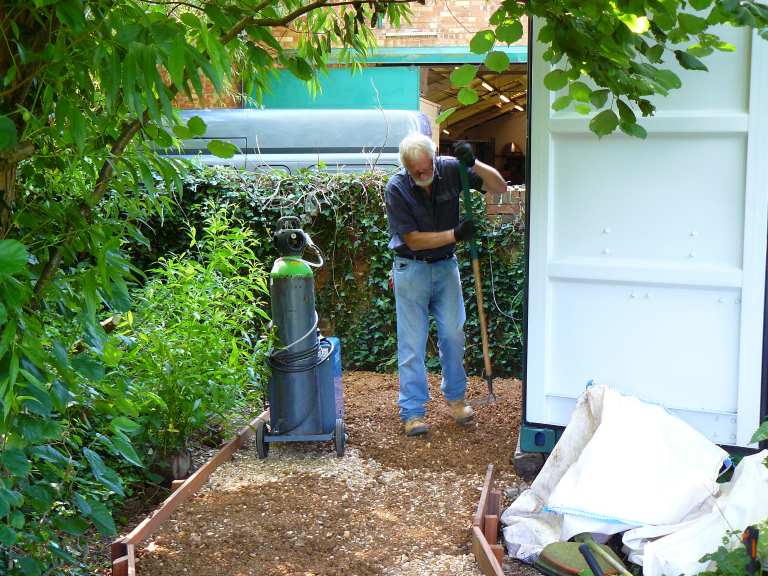
Volunteers also
cleared vegetation from around Rowans on the north
meadow and the Horse Chestnuts in the south meadow. I
warned the volunteers to take care not to cut down the
Marsh Woundwort which is now flowering well
immediately in front of the Horse Chestnuts. I counted
40 flower spikes of this attractive plant.
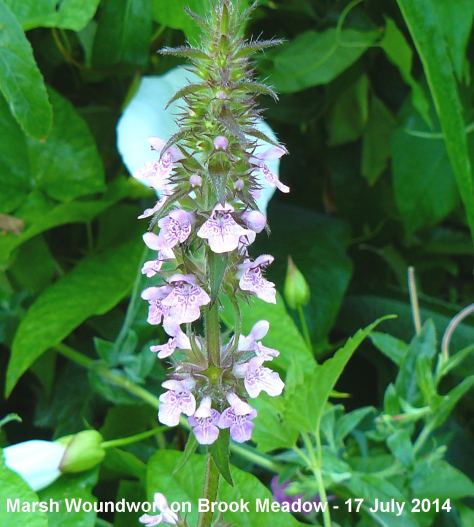
Warblington
shore
Peter
Milinets-Raby had an hour long check of the incoming
tide along the Warblington shore this lunchtime (1pm
to 2pm). Very hot and too much heat haze to get
details.
Off Pook Lane: 4 Greenshank (one with rings), 5
Curlew.
Off Conigar Point: 3 Greenshank (one with rings -
almost certainly the same birds from the other day. I
noted today that 4 flew off towards Portsmouth Harbour
and the other three headed to Thorney. 14 Lapwing, 2
adult Lesser Black-backed Gulls with two recently
fledged young. 2 Common Gulls, 4 Curlew.
In the cemetery a Song Thrush was bashing the living
daylights out of a snail with some incredible force!
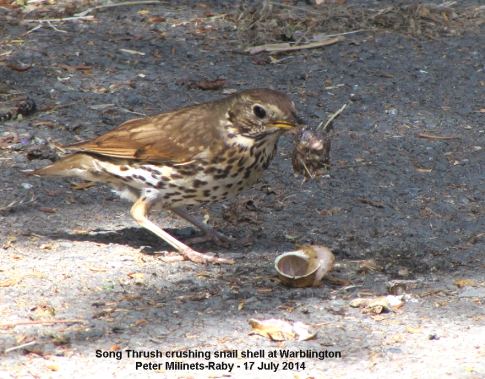
Buzzard
or Kestrel?
Peter thinks
the photo of the bird of prey on the Warblington
church roof in yesterday's blog is a Kestrel not a
Buzzard.
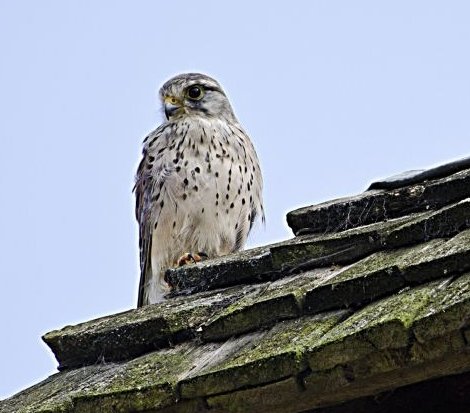
Looking closely at the
photo I can see what he means in that the streaky
spots on the breast are certainly Kestrel like, though
Buzzard also has them. This illustrates the problem of
idenifying a bird from a photo which shows only part
of the bird and does not give any clear indication of
its size. Though looking again, the size of the bird
in comparison with the roof tiles does suggest a
Kestrel rather than a Buzzard.
Hampshire
Farm
Chris Oakley
has been doing a good job in gathering up rubbish from
in and around the pond on the Hampshire Farm site. He
ended up with a bin-liner full, dirty work but very
satisfying, he said. I think Chris should think about
starting up a Friends of Hampshire Farm group!
Chris has been taking photos of the many damselflies
that come to the pond - he has counted 25 individuals
and has identified Common Blue and Blue-tailed and a
new one for the site Red-eyed Damselfly - the
male of which has very distinctive red eyes. Here is
Chris's photo of a pair mating.
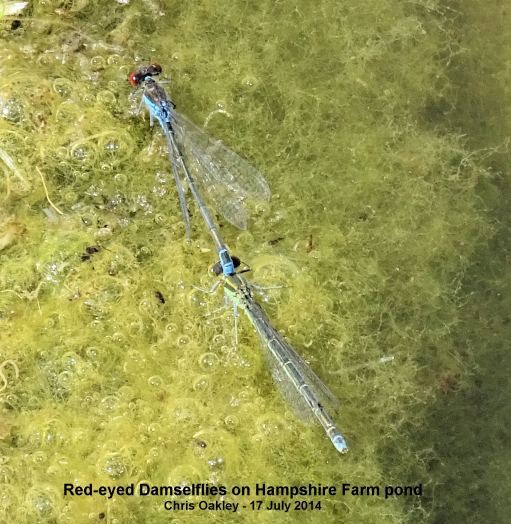
Swift
in house
As a follow up
to my piece about our local Swifts yesterday, John
Williams, my neighbour from across the road told me
about a unique experience he had when a Swift few into
his bedroom through a small gap in the open window. He
managed to capture the bird in his hands and take it
outside from where it immediately flew off. This was
probably one of the young birds that have been flying
around in family parties, investigating nesting sites
for next year.
WEDNESDAY
JULY 16 - 2014
Mute
Swan news
Juliet Walker
was up and about with her camera very early this
morning. After a visit to Locksash Lane to photograph
Hares, she called in at the town millpond at about
6.30am and was delighted to find the single cygnet
still intact. It was looking very perky and on a
breakfast sortie around the pond with the cob and pen.
Juliet caught it in this photo nibbling at the
concrete wall at the edge of the pond, presumably
there is something nutritious there.
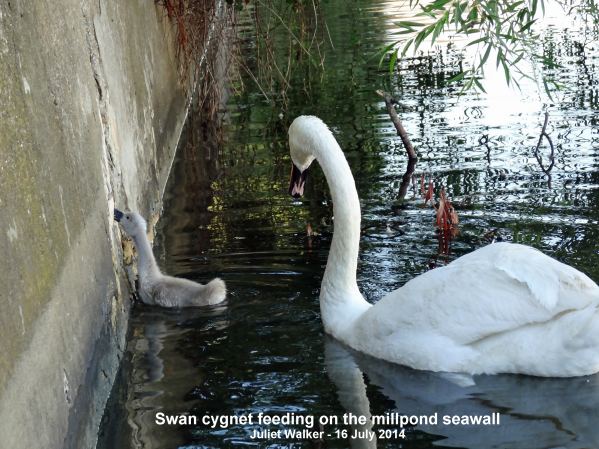
Hollybank
Woods
I had a
pleasant walk through the eastern section of the woods
before lunch this morning - the coolest place I could
think of! I was hoping for some butterflies, but the
woods were remarkably quiet in the insect front.
Despite waiting for about 20 minutes at my favourite
Lorton seat on the eastern bridleway all I saw was
Speckled Wood, Peacock and a fleeting fly past from a
Silver-washed Fritillary.
However, a bit later I did get a nice view of a
White Admiral fluttering around on the main
track just south of the Holly Lodge junction. It
perched long enough for me to get a few photos. This
photo shows both the brightly patterned underwing and
the darker upper wing cross by a white band.
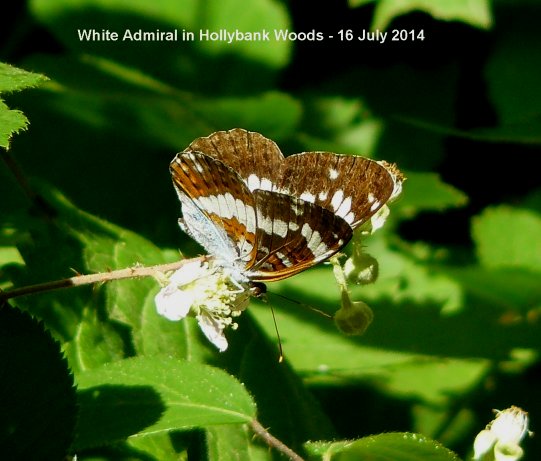
I collected a few
samples of grasses and sedges along the north eastern
path for my wild flower vases, mainly Common
Bent-grass, False Brome, Yorkshire Fog, Giant Fescue,
Wood Sedge, Remote Sedge, Soft Rush.
I was interested to find some Dense-headed Heath
Wood-rush (Luzula multiflora ssp congesta)
along this path, for the first time. I looked in the
usual spots in the woods where I have found this
fairly rare plant before, but did not find any. But
good to know it is still in the woods.
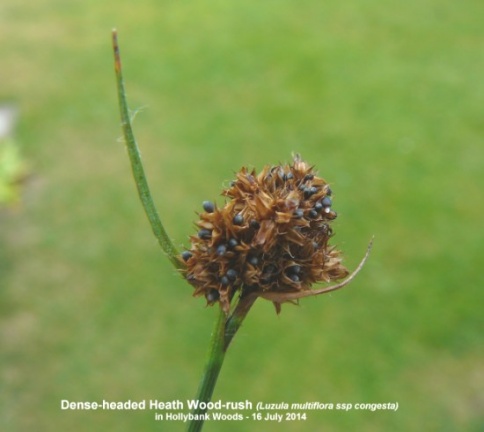
Swifts
I spent much
of the afternoon sitting in the garden watching
several Swifts scything through sky over the Bridge
Road houses, occasionally swooping low. What superb
birds! Later in the afternoon numbers gradually built
to around 12, though feeding higher in the sky. This
was the most I have recorded this year. I tried taking
photos, but they move much too fast. This was my best
effort!
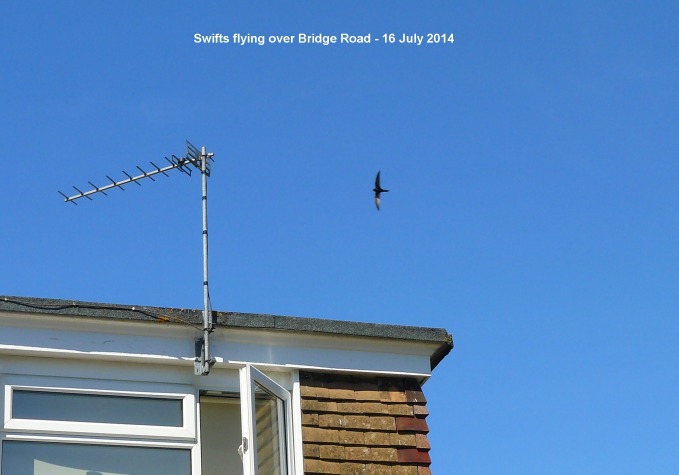
Juvenile
Buzzard - correction
probably a Kestrel - see tomorrow's
blog
Joyce Sawyer
and her husband were lucky enough to get this photo of
a juvenile Buzzard sitting on the corner of the spire
of the church at Warblington on Monday (July 14).
Young Buzzards are often quite pale like this one with
streaks down the chest. This is most likely one of
this year's young birds from a nest on Warblington
Farm.
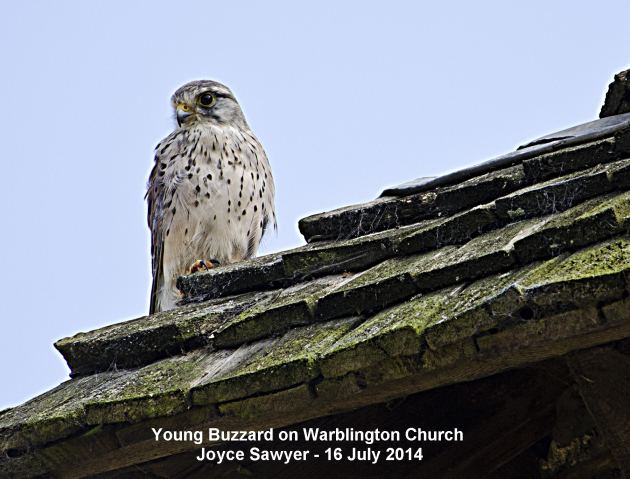
Strange
Fox behaviour
Elaine Morgan
relates some unusual behaviour by the foxes in Valetta
Park which have been delivering hen's eggs to her and
her next door neighbour for some months! It started in
the Spring when Elaine would find a few broken bird's
eggs and the occasional hen's egg - unbroken - in her
flower beds. A week or so ago Elaine's neighbour was
watering a pot which is attached to the top of a 5
foot wooden fence and she found - in place of her
plant - an unbroken hen's egg in the pot! A fox had
been seen running along the top of the fence that
morning. Has anyone heard of anything like this
before?
Hayling
Oysterbeds
Chris Cockburn
reports a good breeding season for Black-headed Gulls
on the Hayling Oysterbeds, but what looks like a
'disastrously poor' season for Common Terns.
"The majority of the
black-headed gull youngsters are now fledged
and the numbers of family groups have started
diminishing. Productivity is estimated to be at least
1.5 fledged birds per pair. However, some pairs have
not produced any young, indeed may not even have laid
any eggs; but, their magnificent nests are a sight to
behold.
The Mediterranean
gulls have been less successful with only three of
the original nine nest sites having broods (of 2, 2
and 1 youngsters). The poor overall productivity may
be explained by the fact that some of the original
pairings were of adult and 2nd summer birds. It has
also been a relatively dry spring/summer and
earthworms may be hard to find.
The common terns
might be heading for a disastrously poor breeding
season. Common tern AONs (Apparently on Nest) were
seen in late May and reached a peak of c96 AONs by 26
Jun with a few very recently hatched chicks seen on 30
June. Recently, no chicks have been seen and on most
days apparently -new pairs of terns have been seen
displaying, showing post-breeding moult behaviour etc
while some have started (re-started?) nesting
activity. It is possible that these pairs have lost
their first egg clutches and are attempting to re-lay.
To add to their problems, many nests were flooded out
by the recent surging tides (particularly the tides of
13 & 14 July). The behaviour is not easy to
explain without closely inspecting the nests.
The most likely cause
is either predation of eggs/small chicks or that the
adults are not in good breeding condition. The most
likely predators are either failed Mediterranean
gulls, which have been regularly flying "low &
slow" over the colonies and even strolling about on
the islands, or rats, which were the cause of nest
failure in 2005 & 2006. The common terns were very
late in starting to nest, indicating a food problem in
the harbour and with frequent windy conditions making
it difficult for the terns to catch prey fish, it is
quite possible that they are not in good breeding
condition.
The pair of
oystercatchers that started nesting on June 23
failed after only eight days, almost certainly due to
predation of eggs. The main suspects are Mediterranean
gulls; but rats might be the culprits (swimming out at
night when wind speeds drop). "
Managing
out of town road verges
It is good to
see Hampshire County Council us taking a responsible
approach to managing out of town road verges in
respopnse to the guidelines from Plantlife.
See . . . http://www3.hants.gov.uk/hantswebnewslist.htm?id=642516&page
"Plantlife has asked
councils to cut the full width of the verge once a
year, no earlier than the end of August and no later
that the end of March. In Hampshire, the full rural
verge width is actually cut just every three years to
allow for the natural ecosystem as far as possible.
When it is cut in the three year cycle, this is done
after the end of August.
"The second request is
to refrain from cutting verges between April and
August except to maintain sight lines or for other
road safety purposes. Hampshire County Council does,
indeed, cut verges at this time, specifically and only
for these reasons. The width cut is just one
metre.
"The third request is
to gather and remove cuttings wherever possible, and
this is where we will have to agree to differ. As we
cut the full width of the verge only every three
years, we do not think the cuttings are detrimental to
wildlife. On balance, because of the significant cost
of removal and transport of cuttings from the 2,000
miles of rural verges we look after, together with the
increased traffic of heavy vehicles through
Hampshire's rural villages this would entail, we leave
cuttings to naturally compost where they
are."
Wildlife
crime
Nik Knight
provides suggests a good web site to get advice about
wildlife crime, with links to the RSPB legal team and
the Birders Against Wildlife Crime website, where
there is excellent advice as to what to do when a
wildlife crime is suspected.
See . . . www.swift-conservation.org
For
earlier observations go to . . July
1-16